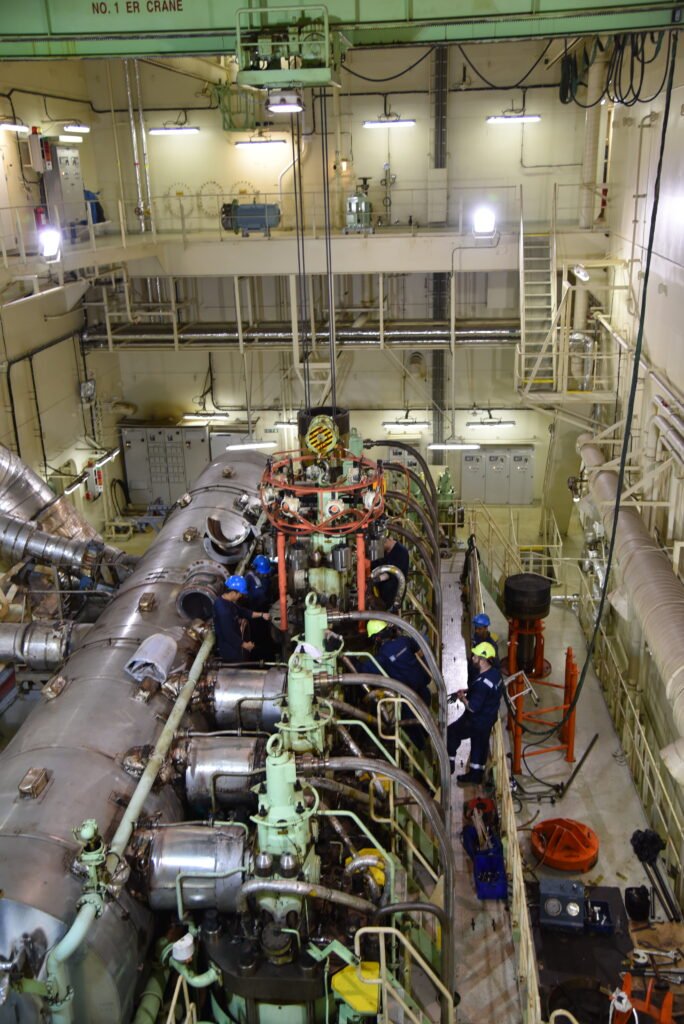Understanding the Exhaust Receiver in Slow Speed Marine Engines
In the complex world of marine engineering, every component of an engine plays a crucial role in ensuring the smooth and efficient operation of vessels. One such vital component is the exhaust receiver in slow-speed marine engines. This article delves into the purpose, operation, and working of exhaust receivers, with insights into designs from leading manufacturers like MAN B&W, Sulzer, and other notable companies.

Purpose of the Exhaust Receiver
The exhaust receiver is an essential part of the exhaust system in slow-speed marine engines. Its primary purposes include:
- Energy Recovery: The exhaust receiver collects exhaust gases from multiple cylinders and directs them to the turbocharger. The energy from these high-temperature gases is harnessed to drive the turbocharger, improving the engine’s overall efficiency.
- Gas Equalization: It helps in equalizing the exhaust gas pressure from different cylinders, ensuring a uniform flow to the turbocharger. This uniformity is critical for the optimal performance of the turbocharging system.
- Pulse Smoothing: In multi-cylinder engines, exhaust gases are expelled in pulses. The exhaust receiver smooths these pulses, reducing fluctuations and ensuring a steady flow of gases.
- Acoustic Dampening: It reduces the noise generated by the exhaust gases, contributing to the overall noise reduction of the engine.
Operation of the Exhaust Receiver
The operation of the exhaust receiver is straightforward yet vital. Here’s how it works:
- Collection of Exhaust Gases: As the engine operates, each cylinder expels exhaust gases after the combustion process. These gases are directed into the exhaust receiver through individual exhaust manifolds.
- Pressure Equalization: The exhaust receiver serves as a common chamber where these gases are collected. It equalizes the pressure differences from the various cylinders, providing a balanced flow towards the turbocharger.
- Energy Transfer: The hot exhaust gases enter the turbocharger turbine, where their energy is used to compress the incoming air. This compressed air is then fed back into the engine, enhancing its efficiency and power output.
- Exhaust Emission: After passing through the turbocharger, the exhaust gases are finally expelled through the ship’s exhaust system, often passing through additional emission control devices to reduce environmental impact.
Working Mechanism of the Exhaust Receiver
The detailed working mechanism of the exhaust receiver involves several technical aspects:
- Design and Construction: Exhaust receivers are typically made from high-temperature resistant materials like cast iron or steel to withstand the extreme conditions within. They are designed to handle the high pressure and temperature of the exhaust gases, ensuring durability and reliability.
- Shape and Size: The shape and size of the exhaust receiver are optimized for the specific engine model. Manufacturers like MAN B&W and Sulzer design their exhaust receivers to maximize the efficiency of the turbocharging system while minimizing back pressure on the engine.
- Mounting and Installation: The exhaust receiver is usually mounted close to the engine cylinders, ensuring minimal heat loss and efficient gas flow. It is securely attached to prevent vibrations and withstand the operational stresses of the engine.
- Maintenance and Inspection: Regular maintenance and inspection are crucial for the exhaust receiver. This includes checking for cracks, corrosion, and ensuring that the connections to the manifolds and turbocharger are secure. Any build-up of soot or carbon deposits must be cleaned to maintain optimal performance.
Leading Manufacturers: MAN B&W, Sulzer, Wärtsilä, and Mitsubishi Heavy Industries
Several prominent manufacturers of slow-speed marine engines have made significant contributions to the design and efficiency of exhaust receivers:
- MAN B&W: Known for their innovative engineering, MAN B&W designs exhaust receivers that optimize gas flow and energy recovery. Their exhaust receivers are integrated with advanced materials and design techniques to withstand the harsh marine environment.
- Sulzer: Sulzer’s exhaust receivers are renowned for their robust construction and efficiency. They focus on delivering consistent performance with minimal maintenance requirements. Sulzer’s designs often incorporate features that enhance acoustic dampening and gas equalization.
- Wärtsilä: A leading global player in marine and energy markets, Wärtsilä designs exhaust receivers that are highly efficient and reliable. Their receivers are known for their durability and performance, incorporating the latest technological advancements to ensure optimal engine function.
- Mitsubishi Heavy Industries: Mitsubishi designs exhaust receivers that are durable and efficient, focusing on maximizing the performance of their marine engines. Their designs are known for robustness and reliability in demanding marine environments.
The Invention of the Exhaust Receiver
The concept of an exhaust receiver dates back to the early days of engine development. However, pinpointing a single inventor is challenging as the technology evolved over time through contributions from various engineers and manufacturers. The development of the exhaust receiver is closely tied to the advancement of turbocharging systems in marine engines, which became more prevalent in the mid-20th century.
Conclusion
The exhaust receiver is a critical component in slow-speed marine engines, contributing significantly to energy recovery, pressure equalization, and overall engine efficiency. Understanding its operation and working mechanism is essential for both amateur enthusiasts and experienced marine engineers. With leading manufacturers like MAN B&W, Sulzer, Wärtsilä, and Mitsubishi Heavy Industries continuously advancing their designs, the future of exhaust receivers looks promising, driving the marine industry towards greater efficiency and sustainability.
For more detailed insights and technical specifications, it’s always beneficial to refer to manufacturer manuals and stay updated with the latest advancements in marine engineering technology.





